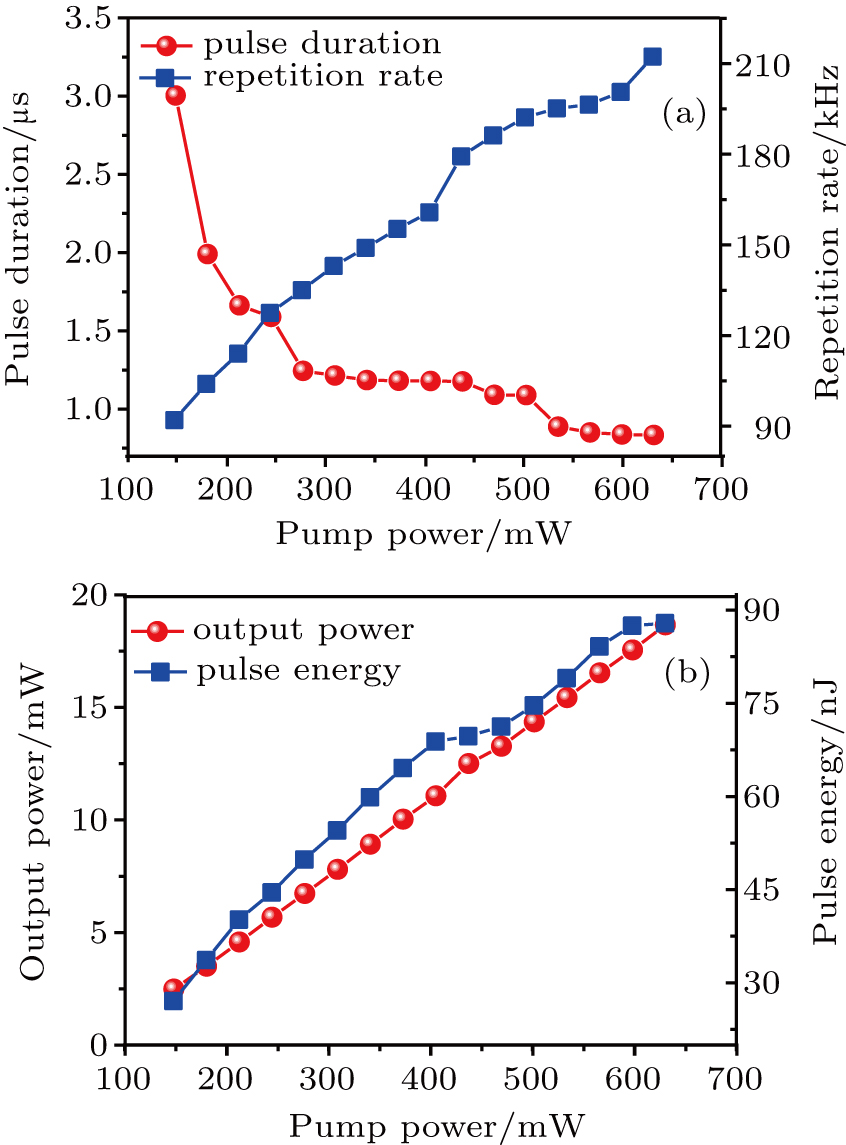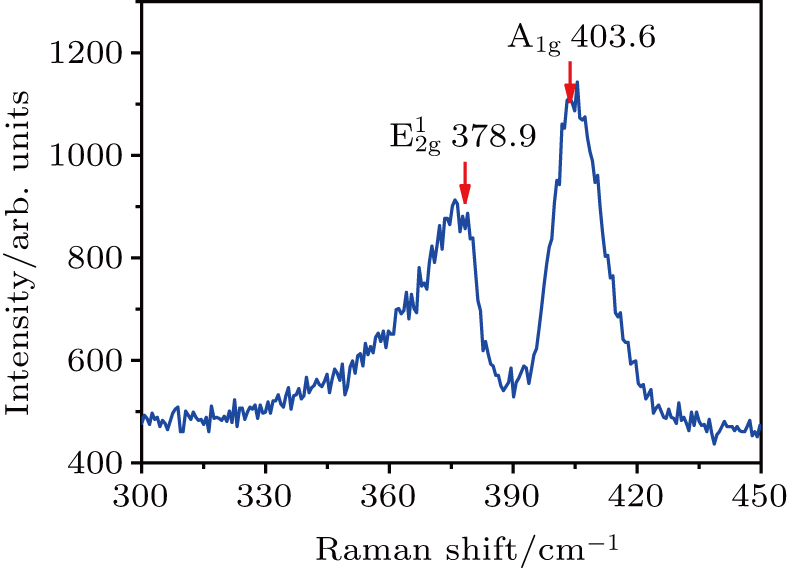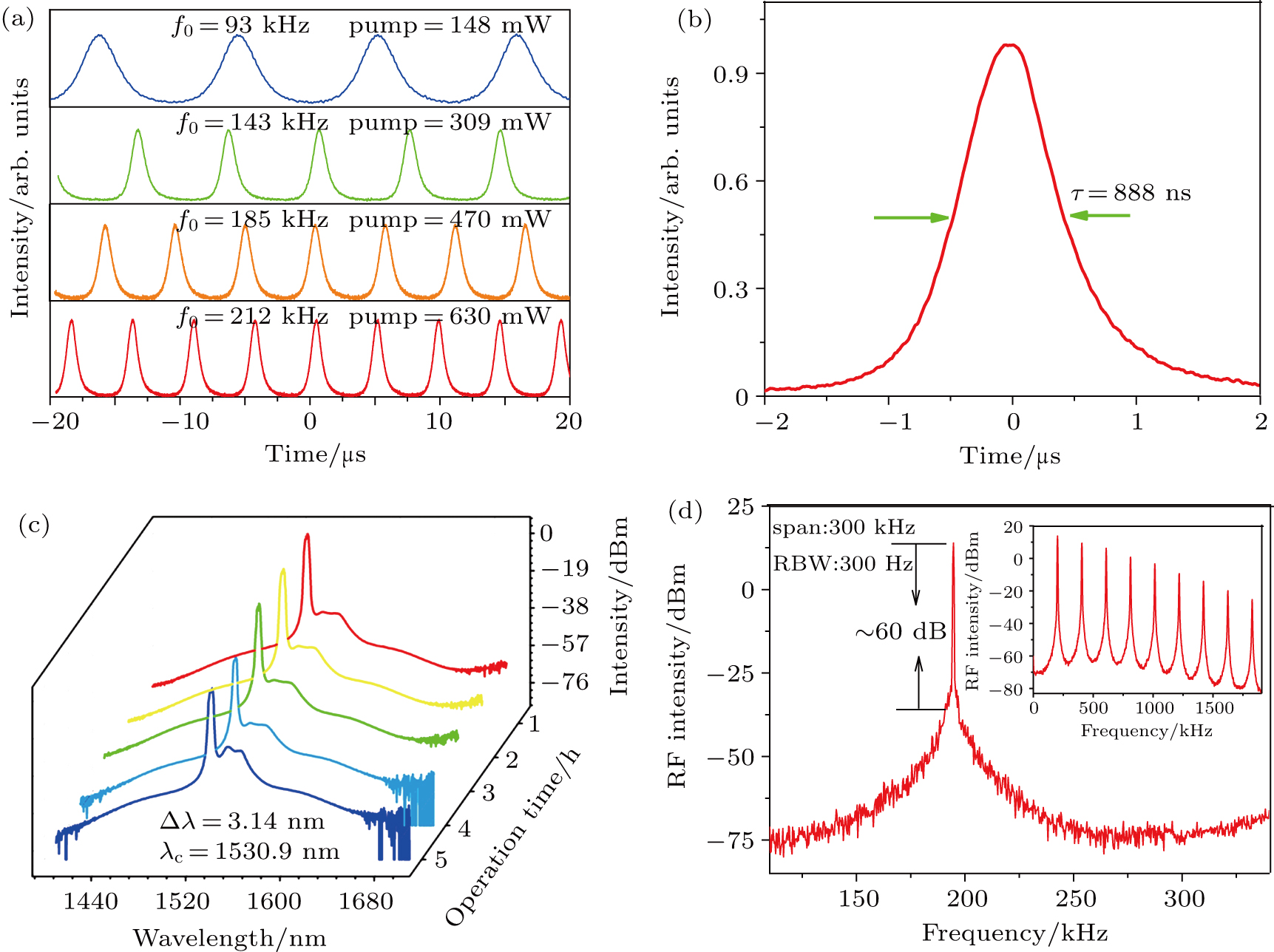† Corresponding author. E-mail:
Project supported by the National Natural Science Foundation of China (Grant No. 11674036), the Beijing Youth Top-notch Talent Support Program, China (Grant No. 2017000026833ZK08), the Fund of State Key Laboratory of Information Photonics and Optical Communications, Beijing University of Posts and Telecommunications, China (Grant Nos. IPOC2016ZT04 and IPOC2017ZZ05).
Due to the remarkable carrier mobility and nonlinear characteristic, MoS2 is considered to be a powerful competitor as an effective optical modulated material in fiber lasers. In this paper, the MoS2 films are prepared by the chemical vapor deposition method to guarantee the high quality of the crystal lattice and uniform thickness. The transfer of the films to microfiber and the operation of gold plated films ensure there is no heat-resistant damage and anti-oxidation. The modulation depth of the prepared integrated microfiber-MoS2 saturable absorber is 11.07%. When the microfiber-MoS2 saturable absorber is used as a light modulator in the Q-switching fiber laser, the stable pulse train with a pulse duration of 888 ns at 1530.9 nm is obtained. The ultimate output power and pulse energy of output pulses are 18.8 mW and 88 nJ, respectively. The signal-to-noise ratio up to 60 dB indicates the good stability of the laser. This work demonstrates that the MoS2 saturable absorber prepared by the chemical vapor deposition method can serve as an effective nonlinear control device for the Q-switching fiber laser.
The saturable absorber (SA), as a natural light modulation device, is the key part of the pulsed fiber laser in Q-switching and mode-locking. Semiconductor saturable absorber mirrors (SESAMs) are the most well-researched and mature SAs, and we attribute the success in application to the controllable absorption wavelength, saturation threshold, modulation depth, and relaxation time.[1,2] However, the relatively high cost and narrow working bandwidth of SESAM have urged researchers to seek new alternatives for them. Then, the rise of graphene has meant two-dimensional (2D) materials are gradually being used more and more.[3] Some of the most representative materials that can be used as SAs have been studied in depth.[4,5] The unique zero band gap structure of graphene impels it to own the wider working wavelength than other 2D materials. The ultrafast recovery time and strong nonlinearity of graphene further prove that graphene can be a powerful candidate for SA.[6–9] Topological insulators (TIs) are also interesting because of their large modulation depth and nonlinearity.[10–13] The superiorities of TIs in light modulation contribute to their great potential in optoelectronics applications. Black phosphorus (BPs) maintain a direct band gap whether they are a bulk or layered structure. Their band gap is adjustable from 0.3 eV to 1.5 eV, which indicates that it is easy to make a breakthrough in the application of photon and photoelectron in the near infrared band.[14–18] In addition to these classic materials, some novel 2D materials have also begun to arouse interest due to their unique electronic and optical characteristics. BP quantum dots (BPQDs), which are able to combine the quantum confinement and edge effects, exhibit excellent nonlinear optical response according to previous studies.[19] Moreover, BPQDs have been successfully used in mode-locked erbium-doped fiber laser (EDFL). MXene, as another kind of new member of the 2D material family, shows good conductivity, tunable bandgap, and ability to perform ion intercalation. It has reported that MXene performs optical manipulation in photonic applications, similar to or better than graphene.[20]
In transition metal dichalcogenides (TMDs), a layer of M (Mo, W, etc.) atoms is sandwiched between two layers of X (S, Se, etc.) atoms, so the chemical formula of TMDs is generally written as MX2. The neighbor layers of TMDs are bonded with weak van der Waals force, which indicates layered nanosheets are easily separated from the sample.[21–36] From previous work, the band gap of TMD varies with the number of layers, and so the consequent layer-dependent electronic and optical characteristics are attracting increasing attention.[37–39] Among TMDs, MoS2 is prominent considering its performance in photoelectrons. It is reported that the nonlinear optical response of MoS2 is better than graphene.[40,41] The few-layer MoS2 unambiguously exhibits broadband absorption from previous work.[42] Furthermore, it is found that the starting Q-switching operation threshold of MoS2 is small under the same experimental conditions compared with those of the materials of the same kind.[43] The relaxation time of MoS2 is estimated at ∼30 fs as mentioned in Ref. [44], which indicates that it has potential for fabricating the ultra-fast electronic devices.
There are various methods to be chosen in the fabrication of SA. The two most representative top-down methods are mechanical exfoliation (ME)[45,46] with the aid of scotch tapes, and liquid-phase exfoliation (LPE)[47,48] getting dispersant through ultrasonication and centrifugation. These two methods are convenient and low-cost, but the layer number of prepared nanosheets is random. By comparison, the three bottom-up methods, as the common methods, have better performance in the control of the layer number and the quality of the sample, they are the pulsed laser deposition (PLD) method,[49,50] chemical vapor deposition (CVD) method,[51,52] and magnetron sputtering deposition (MSD) method,[53,54] respectively. From previous reports, the layer number of nanosheets prepared by the CVD method tends to be controlled more accurately through adjusting the reaction parameters.
Here in this paper, the MoS2 produced through the CVD method is moved to the waist of the microfiber to form MoS2 SA. Finally, the effective area of the taper fiber is fully covered with gold to prevent it from being oxidized. By means of the interaction between the evanescent field of light and the material, the SA is able to avoid some thermal damage.[55] Furthermore, the long reaction length promotes the MoS2 SA to fully exhibit the optical nonlinearity. The modulation depth (MD) and saturable intensity of MoS2 SA are measured to be 11.07% and 1.871 MW/cm2, respectively. The proposed MoS2 based Q-switching EDFL operates at 1530.9 nm. The corresponding pulse duration and maximum output power are 888 ns and 18.8 mW, respectively. The signal-to-noise ratio (SNR) (up to 60 dB) indicates the stability of the laser. The experimental results further prove the favorable optical modulation ability of MoS2 SA.
The MoS2 nanosheets were grown on the ultrathin quartz plate by the CVD method. Before the synthesis, the sulfur powder of 0.5 g was placed in the reaction chamber, and the MoO3 powder of 0.5 g was placed in the heating center, which was at the downstream of sulfur powder. The ultrathin quartz plate was placed at the downstream of the heating center, which was 20 cm away from MoO3 powder. During the synthesis, the pressure of the chamber was set to be 0.1 Torr (1 Torr = 1.33322 × 102 Pa). Under the drive of Ar flow gas, MoO3 and sulfur vapors were capable of mixing and reacting fully, as the product was brought to the substrate. Because temperature is a key factor for determining the quality of the finished product, the temperature of the chamber was rising at a constant speed of 25 °C/min. The reaction chamber was heated up to 550 °C and maintained this temperature for 0.5 h, then the reaction was finished.
When the chamber cooled down to room temperature, ultrathin quartz plate attached with MoS2 film was achieved. To prevent the lattice structure of MoS2 film from destructing during transfer, the polymethyl methacrylate (PMMA) assisted method was adopted. Before the transfer, the PMMA was spin coated on a large scale over the MoS2 film. The MoS2 PMMA was able to be easily separated from ultrathin quartz plate after the open-air drying of the sample. To obtain the pure MoS2 film, the MoS2PMMA was etched in acetone. Then the pure MoS2 film was soaked in deionized water, which could not only remove the remnants, but also make the film float smoothly with the help of water tension. Finally, the MoS2 film was moved to the conical area of microfiber (SMF-28e), which was observed by using a microscope. The measured diameter of the tapered waist was 12 μm, and the effective contact length between the MoS2 film and fiber was about 2 mm. After the volatilization of superfluous deionized water, the MoS2 film closely adhered to the lateral wall of tapered fiber due to van der Waals interaction. Finally, the effective area of the microfiber was fully covered with gold to avoid rapidly oxidizing the material.
With the aid of the atomic force microscope (AFM), an important device for the nano-scale measurement, we obtained the morphology of the MoS2 surface without damaging the material. Figure
 | Fig. 1. (color online) (a) Surface morphology image of MoS2 film; (b) altitude difference of the surface. |
Raman spectroscopy is considered to be an effective method of determining the specific vibration modes of the material. In Fig.
The schematic diagram of power-dependent feature measurement is shown in Fig.
 | Fig. 4. (color online) Intensity-dependent transmission of MoS2 SA, showing its nonlinear absorber characteristics. |
In Table
| Table 1.
Nonlinear parameters of MoS2 SAs obtained with different fabrication methods. . |
An all-fiber ring cavity in Fig.
The stable Q-switching pulses occur at 147 mW with the increase of pump power. Meanwhile, the repetition rates of the output pulses with different powers are recorded and exhibited in Fig.
According to the experimental monitoring data at different powers, the variation tendency of pulse duration and frequency rate with input power are shown in Fig.
 | Fig. 7. (color online) (a) Variation of pulse duration and frequency rate with pump power, and (b) variation of output power and pulse energy with pump power. |
Performance comparisons of Q-switched EDFL based on different SAs are shown in Table
| Table 2.
Performance comparisons of Q-switched EDFL based on different SAs. . |
By combining the CVD method with the PMMA assisted method, the MoS2 SA based on microfiber is successfully produced. On the one hand, the films prepared by the CVD method are of good uniformity. On the other hand, the gold-plated SA based on microfiber has some advantages in preventing heat-resistant damage, and anti-oxidation. The saturate intensity and MD of MoS2 SA are 1.871 MW/cm2 and 11.07%, respectively. Moreover, the obtained MoS2 SA is successfully applied to the Q-switching EDFL. The shortest pulse duration of laser is 888 ns, and the tunable range of frequency is 92 kHz–212 kHz. The ultimate output power and pulse energy are 18.8 mW and 88 nJ, respectively. The SNR of laser increases up to 60 dB, which illustrates the stability of the operation. These results show that the microfiber-MoS2 SA prepared by the CVD method is able to support stable Q-switching pulse output, and it can serve as an impactful nonlinear control device for Q-switching EDFL.
| [1] | |
| [2] | |
| [3] | |
| [4] | |
| [5] | |
| [6] | |
| [7] | |
| [8] | |
| [9] | |
| [10] | |
| [11] | |
| [12] | |
| [13] | |
| [14] | |
| [15] | |
| [16] | |
| [17] | |
| [18] | |
| [19] | |
| [20] | |
| [21] | |
| [22] | |
| [23] | |
| [24] | |
| [25] | |
| [26] | |
| [27] | |
| [28] | |
| [29] | |
| [30] | |
| [31] | |
| [32] | |
| [33] | |
| [34] | |
| [35] | |
| [36] | |
| [37] | |
| [38] | |
| [39] | |
| [40] | |
| [41] | |
| [42] | |
| [43] | |
| [44] | |
| [45] | |
| [46] | |
| [47] | |
| [48] | |
| [49] | |
| [50] | |
| [51] | |
| [52] | |
| [53] | |
| [54] | |
| [55] | |
| [56] | |
| [57] | |
| [58] | |
| [59] | |
| [60] | |
| [61] | |
| [62] | |
| [63] | |
| [64] | |
| [65] | |
| [66] | |
| [67] | |
| [68] | |
| [69] |





